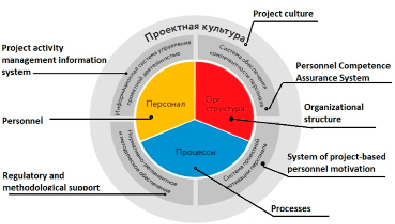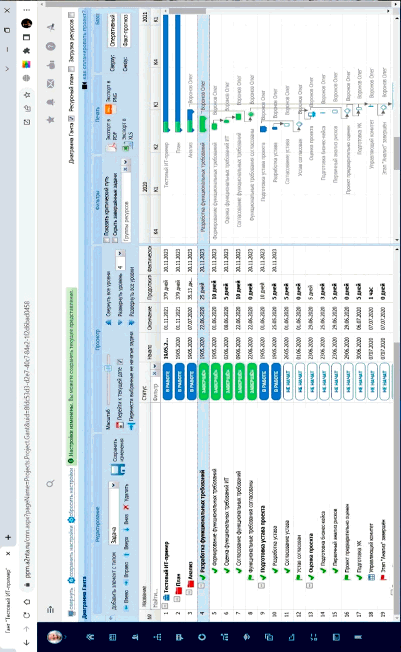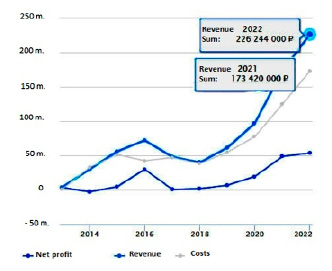It`s impossible to imagine the workplace of a specialist of any profile without a computer currently. The computer helps make work more efficient both at the level of ordinary performers and at the level of senior management [1].
Managing the activities of companies at different levels contains elements of uniqueness, but the results can be more predictable if you use orderly management (fig. 1), the so-called corporate project management system (CPMS) [2].
The results of the analysis show that at the moment many large enterprises in Russia are already using one of the project management information systems (PMIS). A large number of projects are managed using local versions from Microsoft called MS Project. Companies use Microsoft Project Server solutions to manage project portfolios.

Fig. 1. Structure of the Project Management system [3]
Microsoft Project Server in full implementation requires the use of several modules [3]:
- desktop offline client (under Windows OS) designed for project planning;
- server part to support collaboration;
- MS SharePoint for collaboration (editing, storing documents, version control, etc.);
- Project WEB App for implementing the Online part of the solution (the Web part of the system works primarily under Internet Explorer and only on Windows);
- SQL MS Server Reporting Services (SSRS set of local tools and services for creating and deploying reports);
- Microsoft Power BI (Business Intelligence system, platform for business analytics).
But there is a problem of “docking” with 1C software complexes, which are used in the automation of tax and accounting [3].
Similar difficulties are typical when integrating Bitrix24 in project management, because expensive developer services are needed to configure the system for the specifics of a particular company. It is also appropriate to note the high cost of technical support, licenses and a package of annual updates [3]. There is another project management system – Redmine. But Redmine can assign tasks only to a specific employee, and there is no way to hide important data from other participants. The implementation of the Redmine system requires the involvement of highly qualified technical specialists [3].
But the main disadvantage of foreign software products is the risk of sanctions and the possibility of a ban on the use of foreign information systems. For example: the German company SAP disconnected the power engineering company Power Machines from Hybris (a cloud e-commerce platform for B2B and B2C SAP enterprises), Microsoft refused to renew the software license for Bauman Moscow State Technical University.
Thus, the scientific task of assessing and selecting a software package for project management that is devoid of the above disadvantages arises. As a result of an enlarged analysis, the Russian-made ADVANTA project management software package was selected for the study. This information system can be used as an online system with a web interface and licensed cloud access, or as a server application installed locally in an enterprise (fig. 2) [3].
ADVANTA is a cross-platform system and can work on various hardware platforms and operating systems including Windows, Linux, Android and iOS mobile applications. The system is developed on the .NET Framework a software platform released by Microsoft in 2002. The .NET Framework is currently being developed as .NET, a modular open-source software development platform. C# (pronounced C-sharp) is the programming language in which ADVANTA is created. It is a general purpose object-oriented programming language. React is an open-source JavaScript library used to develop user interfaces. Starting from system version 3.25 in 2022, ADVANTA supports the freely distributed PostgreSQL database management system. At the same time, a version of ADVANTA appeared, which can be deployed on Linux OS [4].
ADVANTA is listed in the unified register of Russian software Register entry No. 279 dated 04/02/2016 [5], based on the order of the Ministry of Digital Development, Communications and Mass Communications of the Russian Federation dated No. 138 dated 04/04/2016 [6]. The system was developed in Russia using domestic experience in project management of large corporations and in terms of functionality is analogous to products such as MS Project Server + Sharepoint + BI + Excel and others. At the same time, the main thing is that ADVANTA already initially combines all these products into one system and solves the problem of import substitution of competitive products [3].
The ADVANTA system allows the implementation of modern project management methodologies in large and medium-sized companies, as well as in small project teams. A ready-made project ERP system that covers all project management processes, automates the work of all project participants, and allows you to plan and control project resources. The platform is focused on the rapid development of client solutions without programming [7].
The wide functionality of ADVANTA allows you to automate all project management processes in a single system, providing one tool for project implementation and communication to all participants in project activities. The ADVANTA system can be integrated with other existing systems of the organization CAD, BIM, ERP and others.
Since companies have to operate in difficult conditions, the main task of management becomes to ensure the timely and effective achievement of the organization’s strategic and tactical goals with minimal risks. Thus, the ultimate goal of project management is more focused on the implementation of strategic and tactical objectives than on operational objectives. At the same time the value of project management methods and tools can be successfully used to increase the operational efficiency of enterprises [8].

Fig. 2. ADVANTA Interface
Taking into account the above, a scientific and technical task arises – adapting the ADVANTA system for managing projects for the creation of engineering systems, including:
- heating, ventilation and air conditioning (HVAC) systems;
- water supply distribution and sewage systems (WDS);
- electrical supply systems;
- fire protection systems;
- building management system (BMS);
- automated process control systems for technological processes.
Materials and methods of research
The methods of the classical approach are used to study the possibility of adapting the PMIS project management information system (fig. 3). The developers of the ADVANTA system describe in detail the methods for implementing an PMIS recommended for enterprises and organizations. The above action plan can also be used to explore the possibility of adapting the ADVANTA information system for managing engineering systems projects, namely:
First, determine the basic requirements for a project management system for a given project (what functions and capabilities should the system have for successful project management);
Second, study the capabilities of the ADVANTA information system (documentation and functionality of the system to determine how well it meets the project requirements);
Third, compare ADVANTA’s capabilities with the requirements for a project management system;
Fourth, develop a plan for adapting ADVANTA to the project requirements (adaptation stages, deadlines for completing work and those responsible for completing each stage);
Fifth, test the results of adaptation on a pilot version of the project.

Fig. 3. The classical approach to the implementation of PMIS
Results of the research and discussions
ADVANTA contains ready-made tools for project portfolio management and collaboration [3]:
- register and passports of projects;
- Gant planner;
- delegation of tasks and acceptance of results;
- reporting collection and data visualization;
- document flow;
- knowledge database;
- approvals, discussions and tools of corporate social networks;
All this functionality works in one cross-platform software product that can be deployed on the company’s server or in the cloud. Customization of the system for a specific customer does not require programming and can be performed sequentially, providing a gradual increase in the capabilities of the solution on the ADVANTA platform. The system does not require installation and works as a web application on any browser. The client part does not depend on the operating system (Windows, Unix, MacOS) and can be accessed from mobile devices.
Adaptation of ADVANTA to engineering project management is an urgent task, as it can significantly increase the efficiency of project management and reduce the costs of their implementation. However, before implementing this system, research must be done to ensure that it is suitable for this particular project.

Fig. 4. Company development schedule
A significant proof of the stability of the system’s development, and therefore its “durability and reliability”, is the dynamics of the company’s development (Fig. 4), which, unlike its competitors, invests a significant part of its profits in improving the functionality of the system to increase its profitability among consumers [7].
Conclusion
The conducted research showed that ADVANTA is a universal multifunctional service with a balanced set of capabilities. Almost everything in the system can be customized to your needs without involving developers, and therefore the platform can be used not only by corporations, but also by medium-sized companies. Therefore, it remains to test it according to the developed adaptation plan.

